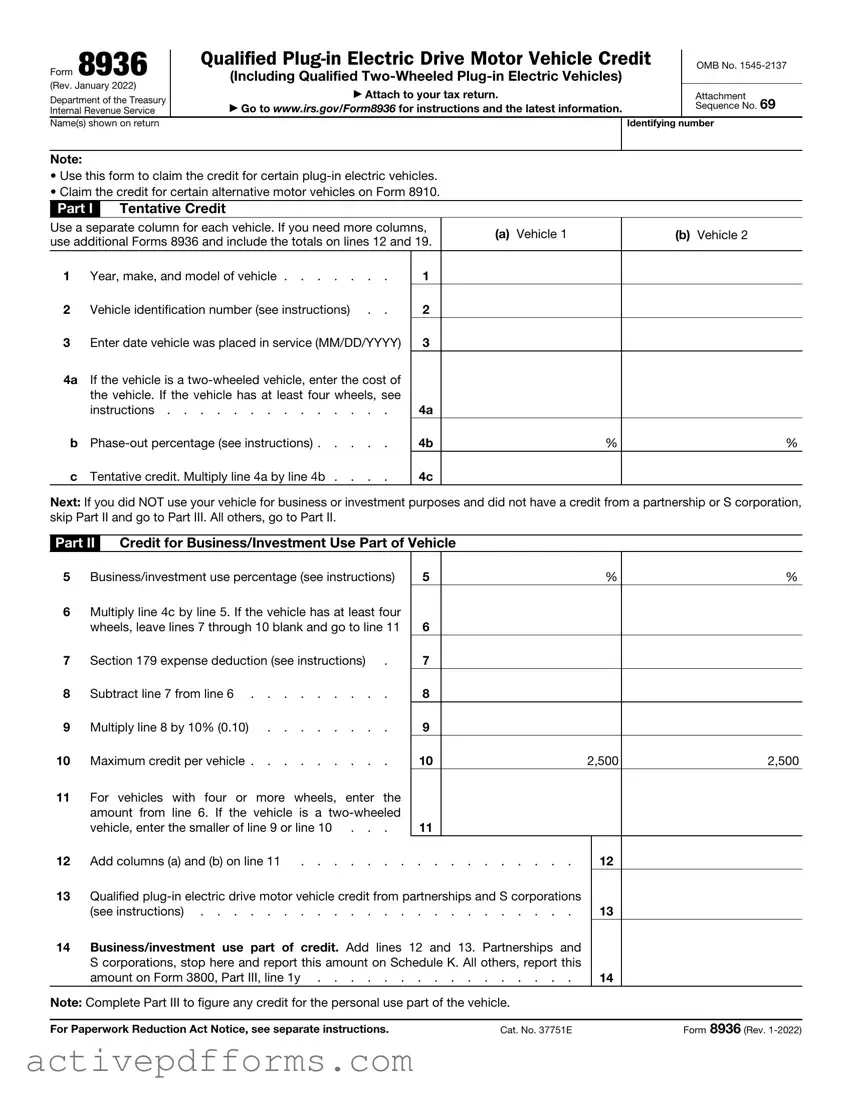
Form 8936 |
|
Qualified Plug-in Electric Drive Motor Vehicle Credit |
|
OMB No. 1545-2137 |
|
|
|
(Including Qualified Two-Wheeled Plug-in Electric Vehicles) |
|
|
(Rev. January 2022) |
|
▶ Attach to your tax return. |
|
Attachment |
Department of the Treasury |
|
|
|
▶ Go to www.irs.gov/Form8936 for instructions and the latest information. |
|
Sequence No. 69 |
Internal Revenue Service |
|
|
Name(s) shown on return |
|
|
Identifying number |
|
|
|
|
|
|
Note:
•Use this form to claim the credit for certain plug-in electric vehicles.
•Claim the credit for certain alternative motor vehicles on Form 8910.
|
|
|
|
|
|
|
|
|
Part I |
Tentative Credit |
|
|
|
|
|
Use a separate column for each vehicle. If you need more columns, |
(a) |
Vehicle 1 |
(b) Vehicle 2 |
|
use additional Forms 8936 and include the totals on lines 12 and 19. |
|
|
|
|
|
|
|
|
|
|
|
|
1 |
Year, make, and model of vehicle |
1 |
|
|
|
|
2 |
Vehicle identification number (see instructions) . . |
2 |
|
|
|
|
3 |
Enter date vehicle was placed in service (MM/DD/YYYY) |
3 |
|
|
|
|
4a |
If the vehicle is a two-wheeled vehicle, enter the cost of |
|
|
|
|
|
|
the vehicle. If the vehicle has at least four wheels, see |
|
|
|
|
|
|
instructions |
4a |
|
|
|
|
b |
Phase-out percentage (see instructions) |
4b |
|
% |
% |
|
c |
Tentative credit. Multiply line 4a by line 4b . . . . |
4c |
|
|
|
Next: If you did NOT use your vehicle for business or investment purposes and did not have a credit from a partnership or S corporation, skip Part II and go to Part III. All others, go to Part II.
Part II Credit for Business/Investment Use Part of Vehicle
5Business/investment use percentage (see instructions)
6Multiply line 4c by line 5. If the vehicle has at least four wheels, leave lines 7 through 10 blank and go to line 11
7 |
Section 179 expense deduction (see instructions) . |
8 |
Subtract line 7 from line 6 |
9 |
Multiply line 8 by 10% (0.10) |
10Maximum credit per vehicle . . . . . . . . .
11For vehicles with four or more wheels, enter the
amount from line 6. If the vehicle is a two-wheeled vehicle, enter the smaller of line 9 or line 10 . . .
12 Add columns (a) and (b) on line 11 |
12 |
13Qualified plug-in electric drive motor vehicle credit from partnerships and S corporations
14Business/investment use part of credit. Add lines 12 and 13. Partnerships and S corporations, stop here and report this amount on Schedule K. All others, report this
amount on Form 3800, Part III, line 1y |
14 |
Note: Complete Part III to figure any credit for the personal use part of the vehicle.
For Paperwork Reduction Act Notice, see separate instructions. |
Cat. No. 37751E |
Form 8936 (Rev. 1-2022) |
Form 8936 (Rev. 1-2022) |
|
Page 2 |
Part III |
Credit for Personal Use Part of Vehicle |
|
|
|
|
|
(a) Vehicle 1 |
(b) Vehicle 2 |
15 |
If you skipped Part II, enter the amount from line 4c. If |
|
|
|
|
|
you completed Part II, subtract line 6 from line 4c. If the |
|
|
|
vehicle has at least four wheels, leave lines 16 and 17 |
|
|
|
blank and go to line 18 |
15 |
|
16 |
Multiply line 15 by 10% (0.10) |
16 |
|
17Maximum credit per vehicle. If you skipped Part II, enter $2,500. If you completed Part II, subtract line 11
18For vehicles with four or more wheels, enter the amount from line 15. If the vehicle is a two-wheeled
|
vehicle, enter the smaller of line 16 or line 17 . . . |
18 |
|
19 |
Add columns (a) and (b) on line 18 |
19 |
20 |
Enter the amount from Form 1040, 1040-SR, or 1040-NR, line 18 |
20 |
21 |
Personal credits from Form 1040, 1040-SR, or 1040-NR (see instructions) . . . . |
21 |
22Subtract line 21 from line 20. If zero or less, enter -0- and stop here. You cannot claim
the personal use part of the credit |
22 |
23Personal use part of credit. Enter the smaller of line 19 or line 22 here and on
Schedule 3 (Form 1040), line 6f. If line 22 is smaller than line 19, see instructions . . |
23 |
Form 8936 (Rev. 1-2022)


